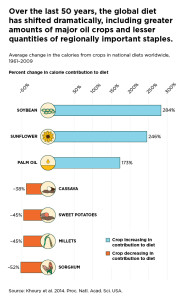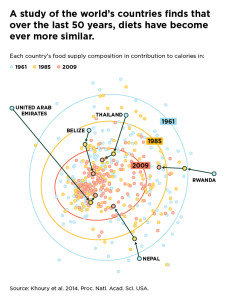Category : News
Published : March 3, 2014 - 2:21 PM
A study published today in the Proceedings of the National Academy of Sciences of the USA (PNAS) examined how national food supplies have changed over the past 50 years for 98% of the worlds population. The authors find that diets worldwide have become much more similar in composition over the past five decades, relying increasingly on a limited set of major crops for the majority of dietary calories, protein, fat, and weight.
Overall people are consuming more food, and a greater proportion of the diet is comprised of energy dense food (plant and animal sources high in fats, oils, and sugars). The crops that provide a dominant proportion of this diet are major staple cereals such as wheat, rice, and maize, as well as a suite of globally important oil crop commodities, particularly soybean, palm, rapeseed, and sunflower oil. The contribution of these oil crops in particular has risen disproportionately over the past half century.
As a result of these dietary changes, regionally important crops have suffered. The study shows significant decreases in the importance of cereals such as sorghum, millets, and rye and root crops such as cassava, sweet potato, and yam. Locally important crops that are not measured on the global scale have suffered the same fate. Without concerted conservation, research and advocacy efforts, the world is in danger of losing a wealth of diverse, adapted alternative crops.
Although changes in diet have occurred worldwide, the areas where food supplies have departed the most significantly from 50 years ago are in Sub-Saharan Africa and in Asia. On average, global diets have increased in similarity by an average of 36%.
The expansion of the global diet and its accompanying production systems has simultaneously increased efficiency and decreased the resiliency of the global food system. Similarities within the food system facilitate technology transfer and food production, which allow for centralized research to impact larger portions of the world. Simultaneously though, these similarities make the global food supply more susceptible to widespread problems such as pests, disease, and climate change, as a greater uniformity of crops are grown over larger areas.
While the availability of more energy dense food has improved food security in some regions in the form of both sufficient quantities and increased nutrients, the increasing homogeneity of contributing crops may contribute further to the occurrence worldwide of diseases associated with over nutrition such as diabetes, heart disease, and some forms of cancer. As over nutrition becomes as important as under nutrition for global public health, maintaining diverse diets could be a key strategy to help the fight against diet related diseases.
- ensure the genetic diversity of major crops through developing and growing a wide range of locally adapted varieties with distinct characteristics,
- increase the conservation and utilization of diverse genetic resources- including crop wild relatives- that underpin crop diversification,
- enhance the nutritional quality of major staples for micronutrients, and/or provide micronutrient supplements,
- encourage a wider range of alternative crops through promotion of the benefits of such crops in the diet and via research in crop development in order to enhance competitiveness, and
- publicly show the links between crop diversity, diet diversity, and health.
Read the article here.
Khoury CK, Bjorkman AD, Dempewolf H, Ramírez-Villegas J, Guarino L, Jarvis A, Rieseberg LH and Struik PC (2014) Increasing homogeneity in global food supplies and the implications for food security. Proceedings of the National Academy of Sciences of the USA. doi: 10.1073/pnas.1313490111. Available online at:www.pnas.org/cgi/doi/10.1073/pnas.1313490111


